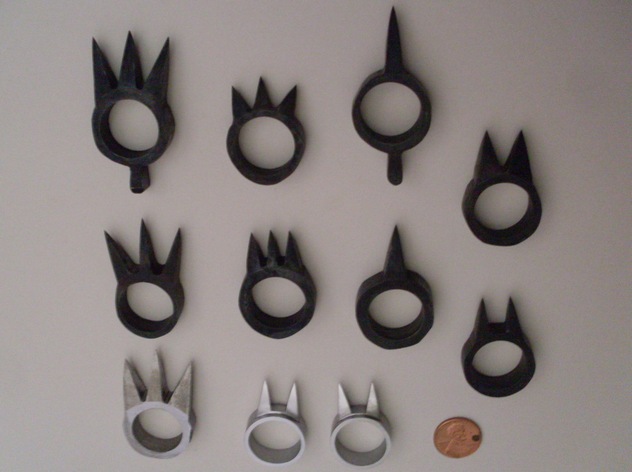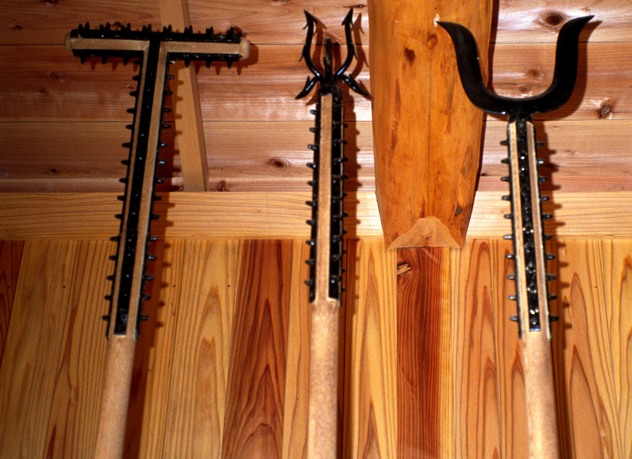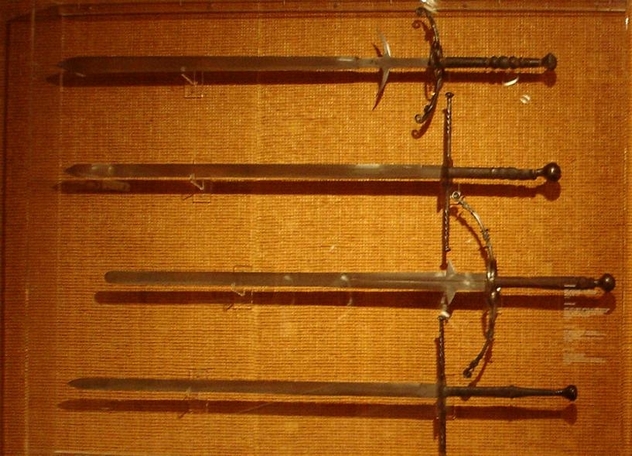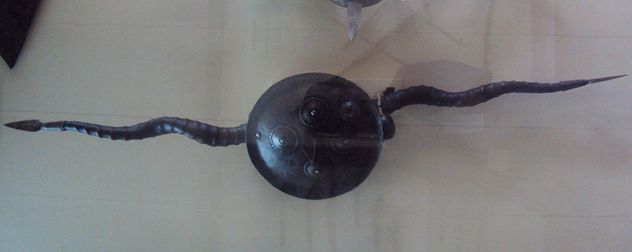Every weapon is made with a specific purpose in mind. Weapons are constantly evolving to meet the needs of the warriors who wield them. Sometimes though, these needs produce weapons that, while no less efficient at executing their purpose, are ultimately quite unique.
每一种武器的制作本质上都带有一种特殊的目的。为了满足武士们使用武器的需求,武器不断演变。虽然有时候根据这些需求而制作的武器,没有有效地实现它们的目的,但归根结底它们是独一无二的。
10.日本忍者:带有金属钉的戒指(Kakute)

kakute were spiked rings used in ancient Japan. Though a similar weapon called the "shobo" was made of wood, kakute were usually iron and had from one to three spikes. A user would generally wear either one or two rings—one for his middle or index finger and another on his thumb. The spikes were usually turned inward and applied to pressure points by gripping limbs or even the neck, which wound stun an opponent and cause a nasty puncture wound. Turned outward, kakute became spiked knuckledusters, though since the purpose of kakute was generally to subdue enemies rather than harm them, this style was not the standard.
Kakute是古代日本使用的一种带有尖刺的指环。虽然一种木头制作的武器"shobo"与它相似,但Kakute 通常是铁制的,并且它还有一到四个铁刺。使用者一般会佩戴一个或者两个指针——一个戴在中指或食指上,另一个则戴在他的拇指上。指针上的尖刺通常是朝向掌心方向,通过抓住敌人的四肢甚至是脖颈并向其要点施加压力,这一动作会使得敌人眩晕,同时也会给敌人造成严重的刺伤。指针朝外时,Kakute 就会变成有刺的指环。尽管,Kakute的目的一般是制服敌人而不是真正伤害敌人,但是它的使用风格却没有固定标准。
Ninjas also used kakute. They were favored by female ninjas, called kunoichi, for whom it was natural to wear rings. Worn inward and tipped with poison, they could use their kakute for quick, fatal attacks. For the female ninja, they proved to be one of her deadliest and most efficient weapons.
忍者也会使用Kakute,特别是女忍者尤其喜欢使用。这些女忍者被称为"kunoichi",她们每一个都会习惯性地带上指环,朝向掌心方向穿戴并且淬以毒药,因此,她们能迅速地给敌人以致命的一击。对于女忍者来说,Kakute是她们拥有的最致命且最有效的武器之一。
9.印度武士拉其普特人:Haladie

Many interesting weapons came out of ancient India, but among the most dangerous was the haladie, a weapon of India's ancient warrior class, the Rajput. The samurai of India, Rajput lived a lifestyle dedicated to fighting and honor, using weapons like the doubled-bladed haladie knife to cut down their enemies.
有许多有趣的武器都产生于印度,但是其中最危险的是Haladie。它是古印度武士拉其普特人(Rajput)使用的武器。印度武士拉普特人以战斗和荣誉为生活方式。他们使用类似双刃刀的武器来砍杀他们的敌人。
Haladie had two double-edged blades connected to the ends of a single handle. It was believed to be a thrusting weapon, although the slightly curved blade could just as easily be used for slashes and parries. Some types of haladie had a metal band similar to knuckledusters covering one side of the handle, where yet another spike or blade could be attached. Almost like something out of a fantasy novel, those types of haladie were perhaps the world's first triple-bladed daggers. An army of ancient Indian warriors would have proven quite intimidating, equipped with both the haladie and their famed double-edged scimitar, the khanda.
双刃刀两面都有刀片——两把刀刃的手柄锻造成一个刀柄连接两片刀片。尽管它那微微弯曲的刀片更易用于挥砍敌人或抵挡攻击,但是它仍被认为是一种用于挺刺的武器。有一些双刃刀的刀柄是用金属打造的,它带有一点指节铜环的风格,并覆盖了另一半刀柄,也就是接近另一边刀片狭窄的根部。这种类型的双刃刀几乎在每一部玄幻小说里面都有提及,它们也许就是世界上首次发现的三刃匕首( triple-bladed daggers)。用双刃刀和印度著名的双刃剑(khanda)作为武装武器的古印度武士军团已经向我们证明了双刃刀的巨大威慑力。
8.日本江户时代警察:袖搦

The sodegarami, meaning "sleeve entangler," was a weapon of the Edo-era Japanese police. Often used by a pair of officers, the sodegarami was a spiked pole they would slide into an opponent's kimono. A quick twist would entangle the fabric and allow officers to bring the offender down without causing (too much) injury. Often, one officer would attack from the front and another from behind, working together to pin the criminal to the ground by their neck. Having two sodegarami tangled up in your kimono made it almost impossible to escape.
袖搦顾名思义,就是"把袖子缠住"。它是日本江户时代警察所使用的武器。一个警察一般使用一双袖搦。袖搦是一个带有短钉的长杆,警察们可以用它刺穿敌人的衣服(此处指日本和服),伴随着一个急速的捻动,袖搦就会缠紧衣物,从而使得他们能够在不伤害(或极少的伤害)罪犯的前提下捉住他(满人性化的)。通常,抓犯人的时候都是一个警察站在犯人的前面,另一个警察站在犯人后面,两人通力合作钳住犯人的脖颈,两个袖搦都缠绕在犯人的衣服上,犯人根本不能逃脱。
It was an important tool for arresting samurai, who by law could only be killed by other samurai. Once an offending samurai drew his katana, an officer would slip his sleeve grabber up the samurai's kimono to entangle him. He would then bring the samurai down non-lethally to avoid unnecessary bloodshed.
对于逮捕一个律法上要求要被其他武士处死的武士来说,袖搦是一个很重要的工具。一旦戴罪的武士拔出他的武器,警察就会使出袖搦缠住他的衣服。这样警察就能毫不费力地控制这个武士,在削弱了他的杀伤力的同时避免了不必要的伤害。
7.双手剑

Perhaps the largest type of sword in history, the Zweihaender was famed for its use by Swiss and German infantrymen to fight off pikes. Zweihaenders were two-handed swords that stretched upward of 178 centimeters (70 in) and weighed anywhere from 1.4–6.4 kilograms (3–14 lbs), though the heavier examples tended to be purely ceremonial. Primarily used against pikes and halberds at longer ranges, some also had an unsharpened part of the blade—called a ricasso—just above the primary guard. The ricasso could be gripped in close quarters combat. These kinds of Zweihaenders usually had a smaller, secondary guard that protruded from the main blade.
Zweihander也许是历史上型号最大的剑。瑞士和德国的步兵们用它来抵御长矛军,它也因此而闻名。双手剑需要双手使用,其剑柄到剑尖长达到178厘米(70英寸),其重量可达到1.4到6.4千克(3-14磅)——但是达到一定重量的剑往往只能应用在仪式上。双手剑主要是用于对抗长距离战争中的长矛和战戟的,一些双手剑的剑身上有一段较钝的地方,它略高于主防护位置,被叫做"无刃部"(或"卡榫")。这个"无刃部"能够减少持握的距离,而带有"无刃部"的双手剑在主剑身突出的地方通常会制有一个较小的护手。
Soldiers who used these immense swords received double pay. The Landsknechts, a feared mercenary band so well respected they even received special exemption from sumptuary laws to maintain their flamboyant dress, helped make them famous. Despite their popularity, however, Zweihaenders eventually gave way to the easier-to-handle pike and became mostly ceremonial. Though they had once been a frontline weapon, advancements in technology eventually regulated them for use by shock troops and mercenaries. In some cases, Zweihaenders were even officially prohibited from battle.
使用这种巨型武器的士兵们一般会得到双倍酬劳。(雇佣步兵,是一个令人恐惧的雇佣军团,但是同时也是备受尊敬的军团。他们甚至从"限奢法令"(sumptuary laws)中获得了豁免权,以保证他们穿上那奢华的军服,这些华丽的衣服也是他们出名的有力助手。)尽管双手剑有很高的知名度,但是它也逃不了让位于其他更易掌握的长矛,而成为节礼武器的命运。虽然它曾经是一个在前线使用的武器,但科技的进步使得它最终只能为突袭部队和雇佣军团使用。在一些地方,双手剑甚至还成为了官方禁止的武器。
6.Madu

Fakirs—ancient Muslim and Hindu ascetics and mendicants—were not permitted to carry weapons, so they had to improvise to protect themselves. They created the madu, which was apparently not officially considered a weapon. The weapon (let's face it, that's what it was) was originally made from two Indian antelope horns connected perpendicularly by a crossbar. With the horn tips at opposite ends, the madu, or "Fakir's horns," was excellent for stabbing, though the fakirs considered it to be primarily for defense.
苦行者(Fakir,古的穆斯林和古印度教的苦行僧们)是不允许携带武器的,所以他们得随机应变以保护自己。他们创造了Madu,一种显然不被官方认可的武器。最初,这种武器(我们得承认,它就是一种武器)是由一块横木垂直连接两个印度羚羊的角而制成。由于羚羊角的两个尖刺被放置在相反的方向,Madu(也被称为"苦行者的角")非常适合用以戳刺,尽管苦行者们认为它主要的功能室用来防卫。
The style of fighting with the madu is still practiced today. Called maan kombu, it is a part of the larger art of silambam: an ancient, weapons-based Indian martial art. Maan kombu ("deer horns") is named after the weapon's material, as fakirs and silambam artists eventually began using other kinds of animal horns. The art form is dying, however, as current laws prohibit the use of deer or antelope horns. There are several variations of the weapon, including one with added steel tips and a shield, making the madu an even more efficient weapon.
使用Madu的搏斗风格一直沿用至今,被称为"maan kombu"。"maan kombu"从属于印度规模较大的武术silambam——古老,使用武器的印度武术。"Maan Kombu"(鹿角)以制作武器的材料而命名,但是苦行者们和silambam的武者们后来都开始使用其他动物的角做材料。然而,因为现行法律禁止羚羊角或者鹿角的使用,这种艺术形式正在消亡。这个武器有很多革新,包括有在Madu上加上一些钢钉和护盾在内的一切革新,都使得Madu成为一种效率更高的武器。
















